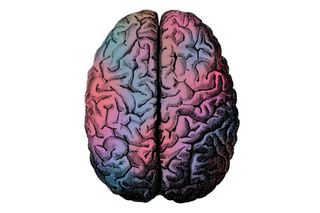
Emerging Brain Research Suggests Human Physiology Doesn’t Reflect a Gender Binary
Brains reflect a gender spectrum in function and structure — so why is being non-binary considered uncommon?

The male brain. The female brain. Ever since the 19th century, when scientists discovered women’s brains weigh roughly five ounces less than men’s brains, the binary of different brains has dogged neuroscientific research so much that the phenomenon has been dubbed “neurosexism.” Such an easy explanation for humanity’s differences in behavior and physiology is so tempting that even though research has revealed time and again how reductive and false it is, the idea persists: men and women, male and female, are diametrically different, therefore their brains – those control centers of all thought, action, and function – must be, too.
They’re not.
Some differences do exist – weight, overall size, and component size vary between men’s and women’s brains (though none of these variations have been linked to differences in intelligence or behavior). Even so, research is revealing that brains exist on a spectrum, in structure as well as function. The findings blur the binary of social construct (gender) and biological fact (sex). And they offer a fuller picture of what non-binary really means.
The androgynous brain
As the gender binary has broken down, so too have stereotypes around what traits are uniquely stronger in women and in men. Such progress can, in part, be traced back to a theory, started in the 70s, of psychological androgyny: that men and women all display the same traits or behavior, though in varying degrees. Those with more overlap of traditionally feminine and masculine traits are considered more psychologically androgynous, a state research suggests is associated with greater cognitive flexibility, optimism, and creativity, smoother social skills, and better mental health.
“A person with psychological androgyny tends to be able to take other people’s perspectives more easily and thereby may have lesser conflicts in his/her interpersonal relationships,” explain Md. Afsar and Pratibha Meena, Ph.D. candidates in neuropsychology at the National Institute of Mental Health and Neurosciences (NIMHANS). An “increased repertoire of behavioral responses” might aid in resilience, as well as empathy.
The ‘soft science’ theory is borne out by a handful of recent ‘hard science’ studies. One, published in 2015, used MRI imaging to compare brain structure and connectivity – the parts of the brain and how they are connected — and concluded that male and female brains both display “mosaics of features” that map to traits considered more masculine or feminine.
Related on The Swaddle:
Transgender Kids’ Brains Reflect Their Gender Identity in Structure and Function
Another, published in January, looks at brain functional connectivity – how the parts of the brain communicate and work together. Previous research in this area has focused on identifying brains as either male or female, but “surprisingly, those classifiers [used to determine a brain’s sex] aren’t very accurate,” says Christelle Langley, Ph.D., a cognitive neuroscience researcher at the University of Cambridge, U.K., and an author of the study. Instead, she and a group of colleagues looked at whether an androgynous brain exists by attempting to measure “how male or how female” a brain is.
They found a cluster of patterns of brain functional connectivity that could be considered female and a cluster of patterns that could be considered male – but they also found a wide range of patterns in between. In fact, only 25% of brains functioned as female, and 25% as male; the other 50% of brains fell along a spectrum.
Langley and the team then looked at the mental health of people with ‘androgynous’ brain functional connectivity. Those at the center of the spectrum — the most androgynous — experienced fewer internalizing symptoms like anxiety and depression. The comparison helped confirm the team had found the physiological roots of psychological androgyny – or had they found the physical effects of the psycho-cultural experience? After all, the brain is malleable, or plastic. Could the way it communicates with itself be shaped by the participants’ experiences of gender in real life?
“It’s a two-way street,” Langley says. “So of course your brain is going to affect your behavior, just as your behavior is going to affect your brain.” Langley adds the team hopes to conduct follow-up research that examines brain functional connectivity in comparison to gender identity, an obvious exploration not possible with the dataset available in this project.
Beyond the (non) binary
However, a spectrum is still rooted in two extremes – thus perpetuating a binary, argues Rebecca Reilly-Cooper in a 2016 critique of the term, and the myth that most people populate the two poles. With potentially half of all people displaying intra-brain communication patterns that fall in the area between, what meaning do these extremes have anymore?
Similarly, what is female and what is male? The biological binary is already breaking down, though a beat or two behind that of gender. Using XX and XY chromosomes to define the female and male “is the crudest understanding” of sex, says Jamuna Rajeswaran, Ph.D., a neuropsychologist at NIMHANS. It obscures a greater sex-related genetic diversity as well as neural diversity.
If brain functional activity provides evidence that a large number of people don’t fall into such neatly defined categories, the male-female divide erodes further — and being non-binary becomes the norm. Given how broad ‘non-binary’ is, the flip could revolutionize how we think about both gender and sex — as merely individualized psychological and physiological traits that contribute to, rather than define, us.
Liesl Goecker is The Swaddle's managing editor.
Related


Weddings, Functions Can’t Impede “Other Citizens’ Right to a Peaceful and Clean Environment”: National Green Tribunal
